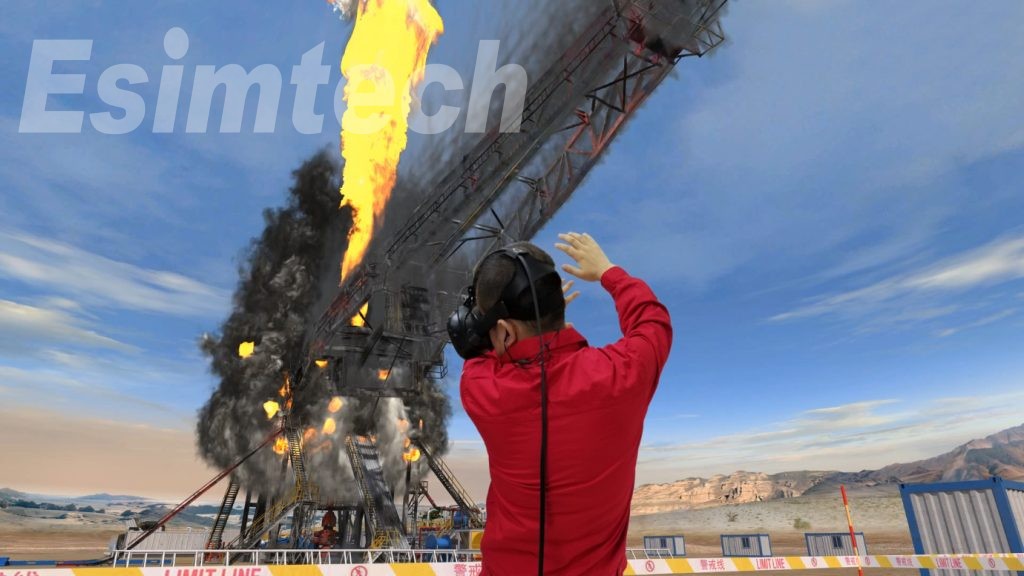What are Different Types of Oil Rig Accidents and How to Prevent Them with Simulation Training
The offshore oil and gas industry stands as a cornerstone of the global energy supply chain, yet it harbors inherent dangers. Oil rig accidents can unleash severe consequences, from injuries to environmental calamities and economic losses. In this piece, we delve into the various types of various types of oil rig accidents and the injuries they can inflict upon workers, shedding light on critical safety concerns in this high-stakes industry.

Types of Oil Rig Accidents
Blowouts: A blowout, the stuff of nightmares in the offshore oil industry, occurs when high-pressure oil or gas erupts uncontrollably from the well. Triggered by equipment failures, human error, or a blend of factors, blowouts often lead to catastrophic explosions. Resulting injuries can include severe burns, traumatic injuries, exposure to toxic gases, and psychological trauma.
Fires and Explosions: These incidents, stemming from equipment malfunctions, electrical faults, or human error, pose significant risks. Fires and explosions can cause extensive damage, including rig destruction, and result in severe burns, smoke inhalation, and traumatic injuries to workers.
Falls and Falling Objects: Given the towering structures of oil rigs, workers are susceptible to falls from heights or being struck by falling objects. These accidents can cause broken bones, head injuries, spinal cord damage, and lacerations, emphasizing the importance of stringent safety measures.
Weather-Related Incidents: Offshore rigs are at the mercy of adverse weather conditions, such as storms and hurricanes, which can lead to rig movements, damage, or topples. Workers may suffer traumatic injuries or drowning, emphasizing the need for proactive safety measures and emergency response plans.
Collisions and Groundings: Collisions between vessels and oil rigs or groundings of rigs can result in structural damage, oil spills, and environmental damage. Injuries may include traumatic injuries, drowning, and environmental impact, highlighting the importance of navigational vigilance and equipment maintenance.
Role of Simulation Training
Simulation technology emerges as a crucial tool in preventing oil rig accidents and injuries, offering several benefits:
Realistic Scenario Practice: Workers can simulate realistic accident scenarios, enhancing their understanding of emergency dynamics and response strategies.
Preventative Measures: Simulation training aids in hazard recognition, empowering workers to proactively identify and mitigate risks.
Response Preparedness: Emergency training simulation prepares workers for swift and effective responses in emergencies, guiding them through assessments, task prioritization, and necessary actions.

Hands-On Experience: Simulation training provides practical experience, boosting confidence and competence in operating equipment, using safety gear, and applying protocols.
Environmental Protection: Simulation training extends to minimizing environmental damage, ensuring workers can contain pollutants and protect the ecosystem in case of accidents.
Conclusion
In conclusion, while the offshore oil and gas industry is vital for global energy needs, it is not without peril. Understanding and addressing these risks demand concerted efforts from rig operators, workers, and regulatory bodies. By prioritizing safety, leveraging advanced technologies like simulation training, and fostering collaboration, the industry can mitigate risks and safeguard lives, the environment, and its own sustainability.
- Art
- Causes
- Crafts
- Dance
- Drinks
- Film
- Fitness
- Food
- Giochi
- Gardening
- Health
- Home
- Literature
- Musica
- Networking
- Altre informazioni
- Party
- Religion
- Shopping
- Sports
- Theater
- Wellness


